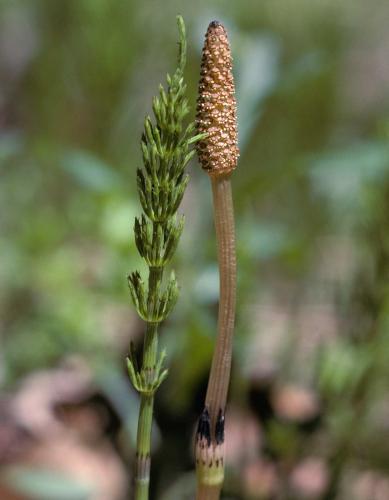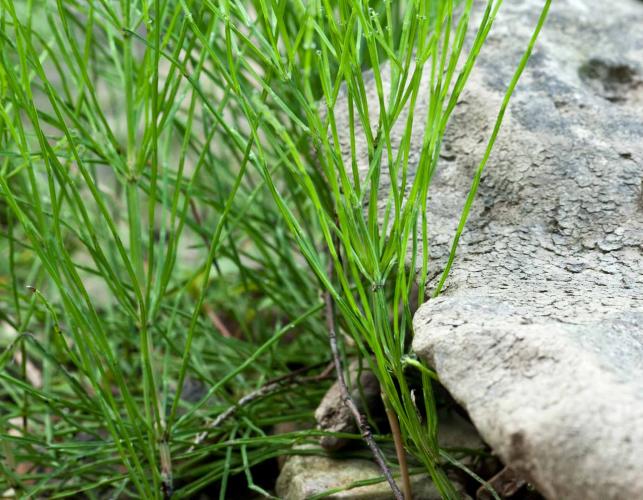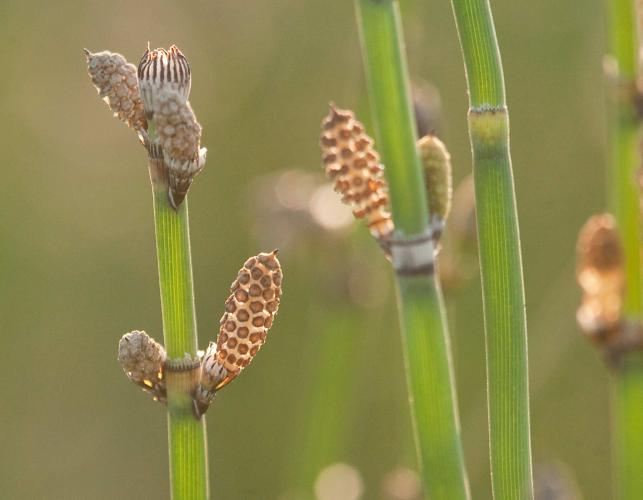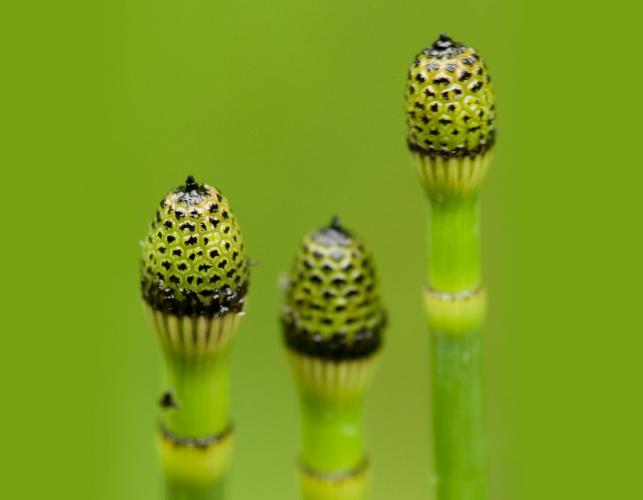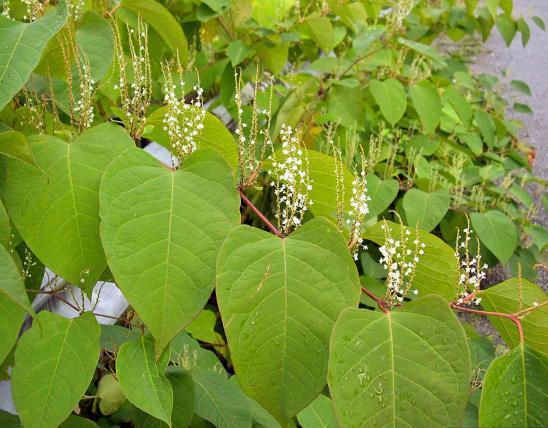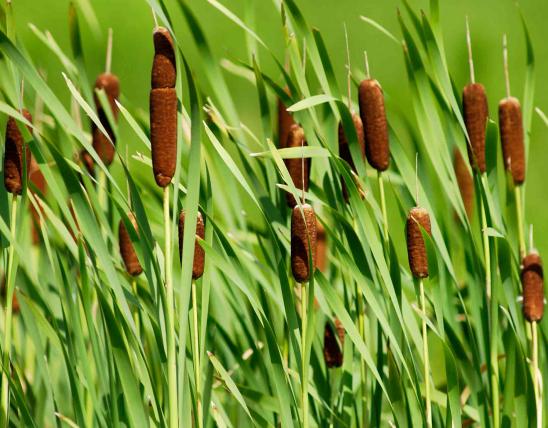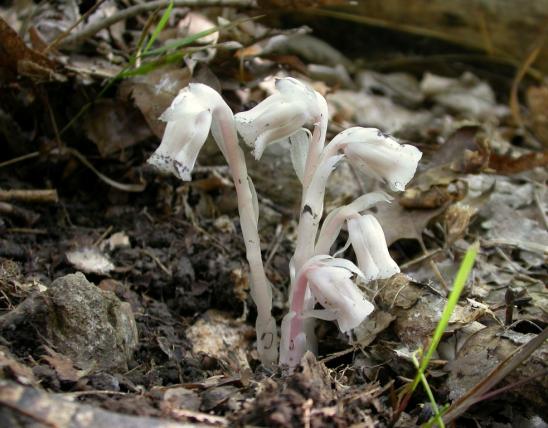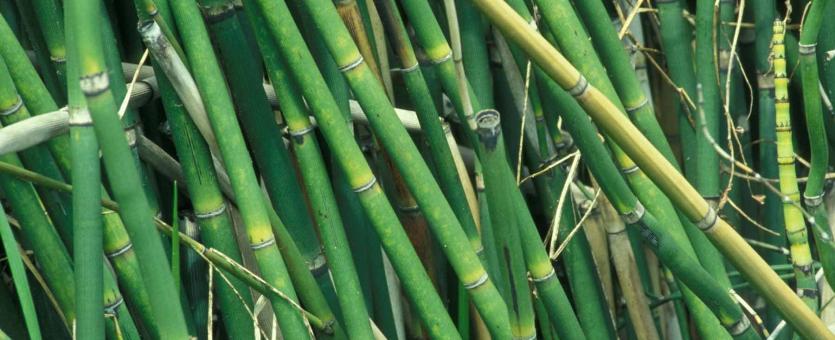
Horsetails, in genus Equisetum, are easily recognized by their unique stems, which are hollow and jointed, usually stand erect, and have lengthwise ridges. They can look a lot like green soda straws. The leaves are small and fused together into a collarlike sheath at each node (joint), and the tips of the leaves are free and scalelike. Horsetails are perennial and grow from rhizomes. The strobili (spore-bearing reproductive structures) are conelike, with dense, 6-sided plates apparent on the outer surface.
Three species of horsetails occur in Missouri.
- Common (or winter) scouring rush (E. hyemale) is also called rough horsetail. Its stems do not branch much, and they are rough to the touch. Leaf sheaths have a wide, dark band near the base, usually with a white band in the middle, and a thin, dark band at the tip. The teeth sometimes persist at maturity. Its strobili have sharp-pointed tips and can be up to about 1 inch long. Spores are shed March–August. This is the most common equisetum in the state. It forms large, dense colonies along roadways and railroad banks. It is scattered nearly statewide, along stream banks, spring branches, rivers, lakes, ponds, ditches, roadsides, and railroads.
- Smooth scouring rush (E. laeviigatum) is much like E. hyemale, except that it has smooth (not rough) stems, green leaf sheaths (sometimes with a dark band at the tip), with the teeth usually shedding before maturity. Strobili tips are rounded, sometimes bluntly pointed. Spores are shed March–July. It is scattered nearly statewide along streams, spring branches, rivers, fens, roadsides, railroads, and sometimes in upland prairies, especially loess hill prairies.
- Common (or field) horsetail (E. arvense) looks quite different from the above two. It has two kinds of stems. Its vegetative stems are green and have regular whorls of branches, while its fertile stems are pink to tan or white and are unbranched at the time when spores are shed. Spores are shed April–May. The fertile stems last only a few weeks, until the strobili have matured and shed spores; then, they wither. When they wither, the sterile stems become more noticeable. This species is scattered nearly statewide, but it is most common north of the Missouri River. It grows along rivers and streams, lakes and ponds, pastures, roadsides, and railroads; it also occurs in freshwater marshes, fens, wet prairies, and edges of bottomland forests.
Height: E. arvense reaches about 2 feet; the other two can reach 5 feet or more.
Statewide.
Habitat and Conservation
Horsetails may live in a variety of habitats, but they are most associated with wet areas, as along streams, the edges of lakes and ponds, and in wetlands, roadsides, railroad ballast, and ditches. The description section above gives precise habitat info for our three different species.
Status
Taxonomy: Horsetails are grouped with club mosses, spikemosses, quillworts, and true ferns into division Pteridophyta, a major division of the plant kingdom. This group is called the “ferns and fern allies” or the “vascular cryptogams.” They are seedless vascular plants: they have vascular (veinlike) tubes for conducting water and nutrients, but they do not produce flowers and seeds. Instead, they reproduce via spores, and their life cycle alternates between sporophyte (spore-producing) generations and gametophyte (sperm- and egg-producing) generations. Usually the gametophyte part of the life cycle is small, looks quite different, and is rarely noticed.
Life Cycle
Like ferns, equisetums have alternating generations. The portion of the cycle we usually see are plants (sporophytes) that produce spores in their conelike strobili. Each tiny spore may germinate to become the next part of the life cycle (a gametophyte). The gametophyte looks quite different from its parent: a small, green, disk- or cushion-shaped, irregularly lobed plant growing at the soil surface. These odd-looking gametophytes develop eggs in structures called archegonia and sperm in organs called antheridia. The sperm must swim to the eggs, so standing water must be present for fertilization to occur. The resulting embryo develops into a new sporophyte plant.
Equisetums may reproduce vegetatively, when portions of rhizomes are washed downstream during floods and later develop new roots and stems.
Human Connections
The sandpapery stems of scouring rushes were once used to scour kitchen and other utensils. The Germans call the plant Zinnkraut, or “tin herb.” The plants’ coarse texture comes from silicates that accumulate on the exterior. Equisetums are used by musicians to clean and maintain reeds for woodwind instruments (it’s sold as “Dutch rush” or “reed rush”), and in Japan for giving a final polish to fine woodwork.
The mathematician John Napier, a Scotsman who lived in the late 1500s and early 1600s, is said to have invented logarithms after pondering the ever-decreasing spaces between the nodes toward the tips of equisetums. Logarithms are useful for calculating the half-life decay of radioactive substances, bacterial growth, population growth, compound interest, and much more. The pH, Decibel, and Richter scales are based on logarithms.
Equisetum has been used in several cultures as a folk remedy, but scientific evidence of its effectiveness is lacking. Certain species have also been eaten in Japan and by Native Americans in the Pacific Northwest, but consuming equisetum is not recommended.
Some horsetails and ferns contain an enzyme called thiaminase, which metabolizes (breaks down) thiamine (a B vitamin) and makes it unavailable for the body to absorb. Too much thiaminase can cause people to have thiamine deficiency, which can ultimately cause liver damage.
Although some property owners may try to grow A. hyemale as a water-loving plant that looks interesting in wintertime, this species spreads very aggressively by its rhizomes. Once established, it can be very difficult to eradicate: its rhizomes spread widely and deep, and even a tiny section of rhizome can become a new plant. Also, it’s resistant to herbicides. If you're considering planting it on your property, we suggest using it only in low, wet places where nothing else will grow, and where its spread and persistence will not be a problem. Otherwise, we suggest limiting it to containers.
Ecosystem Connections
Equisetums are often called living fossils, because they have changed little over the past hundred million years. Their earliest relatives date back more than 350 million years to the Devonian period. This once-diverse family was a dominant life-form in the Paleozoic and Carboniferous periods, and some species were tree-sized. Over time, they and the atmospheric carbon they trapped in their tissues became coal deposits.
The thiaminase present in equisetums is apparently a chemical defense against herbivores. Grazing animals may have a toxic reaction if fed a diet too high in equisetums and ferns.
Despite the name “scouring rush,” Equisetum species are not rushes. True rushes are in the family Juncaceae and are flowering plants much like grasses and sedges. But many people call any tall, grasslike plant growing near water a “rush.”
Equisetums can endure — both in a particular location, and over geologic time. They can survive in a wide range of conditions: wet and dry, hot and cold, where there's low soil oxygen, standing water, saline water, high amounts of metals such as copper, zinc, cadmium, and lead, and soil disturbance.
Equisetums, with their complex underground networks of tough rhizomes, play an important role in stabilizing shorelines and stream banks. The streamside barrier they create prevents soil from washing away during floods, allowing other bottomland plants to grow securely.


